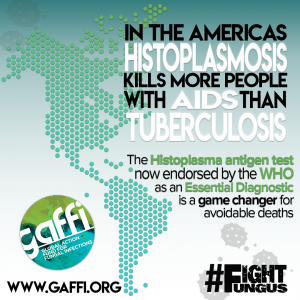
Histoplasmosis kills more people with AIDS than TB in the Americas. The Histoplasma antigen test is a game-changer – that allows diagnosis to be made in over 85% of patients within 48 hours and life-saving antifungal therapy can be given. The WHO have now endorsed its use by listing it in their second EDL, issued this week.
Without antigen diagnosis, incorrect therapy with anti-TB therapy is the usual approach, with death in 1-3 weeks. As the average age of death is 35 years, this represents an tragedy that can be avoided for all concerned.
The most sensitive test for diagnosis is testing the urine for Histoplasma antigen. Two commercial assays are FDA approved and with rollout across the world, at least 48,000 lives could be saved over 5 years.
Histoplasma capsulatum is an airborne infection with a patchy global distribution with some areas hyperendemic. In these areas, including parts of Central and South America, up to 60% of the population have been or are continually exposed to Histoplasma. In those with depressed immunity, notably with advanced HIV infection, disseminated histoplasmosis is common. Presenting with fever, weight loss, cough, skin lesions, abdominal discomfort or diarrhea, pancytopenia (low blood count) and abnormal liver tests, the fungus is so slow growing in the laboratory, that patients historically die before the diagnosis can be confirmed by culture.
The application for listing as an Essential Diagnostic was made by the Global Action Fund for Fungal Infections (GAFFI). It followed GAFFI’s consensus meeting in Kampala, in April 2018 on Essential Diagnostics, with a report now published. Acceptance was also facilitated by publication of a meta-analysis of the value of histoplasma antigen in AIDS, lead by Professor Mathieu Nacher, in the esteemed journal PLOS Neglected Tropical Diseases.
The Manaus Declaration on Histoplasmosis calls for all countries with substantial number of cases of histoplasmosis and AIDS to provide access to Histoplasma antigen testing and appropriate therapy by 2025.